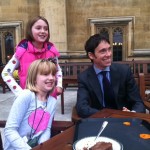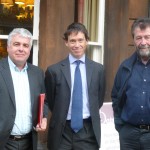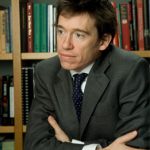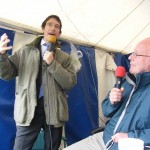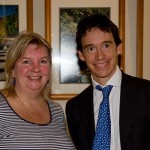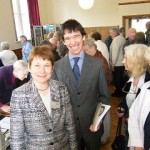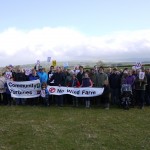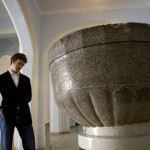
From INTELLGENT LIFE magazine, September/October 2011
Two vast and mostly trunkless legs of stone stand in the hall; near them sits a shattered Bodhisattva, whose hunched shoulders and sorrowful gaze are the work of an Afghan sculptor from 1,700 years ago. In 2001, the Taliban broke it into a hundred pieces. And the Bodhisattva seems to be mourning all the cracks and plaster joints of its reconstruction.
It is difficult not to write about the Kabul Museum as a lament, and perhaps it was ever thus. The single white marble door on your left as you enter probably comes from the Kabul bazaar, burnt by the British in 1842 in revenge for their humiliation in the first Anglo-Afghan war, or from the Royal Palace in the Bala Hissar, destroyed in 1880 during the second British occupation. The museum bears the scars of the rocket that hit it in the spring of 1993; and of the militias who broke into the storeroom the following autumn, ransacking the cases, burning the records and removing most of the collection.
And yet it is not a depressing place. I first saw it at the beginning of 2002. I had walked from Herat to Kabul that winter. I had seen hundreds of pickaxe-wielding villagers, directed by Pakistani traders, uncovering, looting and destroying the ancient city of the Turquoise Mountain, the lost Afghan capital of the Middle Ages. The Taliban had just blown up two monumental Buddhas that had stood, carved into the side of a cliff in the Bamiyan Valley, since the sixth century. I found new craters, left by looters, on mountain ridges at 11,000 feet. In this country of isolated hamlets, the life expectancy was 37, literacy rates in the south were 8%, and archaeological looting had become a common occupation, along with heroin production and mercenary fighting.
Central Kabul seemed like one extended security checkpoint. You were stopped by men who ripped car doors open and pointed their rifles at passengers. You found roads narrowing suddenly into tunnels of sandbags, or closed altogether by concrete blast walls. You were pushed off the street by armoured vehicles with blaring sirens, by embassy convoys, by militias in pick-up trucks.
But the wide, five-mile boulevard leading south-west to the Kabul Museum took one back into a more peaceful nation. You could see the snow peaks on either side. Men, oblivious to the traffic, sat back on empty carts, pulled by ambling donkeys. This had been the first paved road in the country. King Amanullah had driven his seven Rolls-Royces down it in the 1920s, and although, since then, the avenue of plane trees had been cut for firewood, it was still paved. At the end of the boulevard, framed by 15,000-foot peaks and facing the museum, was his great ruined palace of Darul Aman—“the place of peace”.
The museum was not surrounded, like a NATO base, with razor wire and blast walls. Nor was it one of the garish palaces of the new Afghan rich, with bulging filigree balconies and pink cupolas. Nor, again, was it covered with the green tiles favoured by drug barons and warlords, contractors and ministers. Instead, here was a two-storey 1930s villa, with walls of muted grey pebbledash and a small line of white plaster decoration beneath the roof. Outside it in a shed stood two 1950s American cars, partially concealed by brown canvas sheets. And a railway engine, for a railway that does not exist.
Littered with stone capitals, the narrow dusty path leading to the entrance had remained unchanged since the piratical Hungarian archaeologist Sir Aurel Stein visited in 1943 (he died in Kabul at the age of 80 and is buried in the British cemetery). The glass of the ticket booth was plastered with fading postcards. In the tattered pile behind the desk were brochures produced during the Soviet occupation of the 1980s, or President Daud’s regime in the 1970s, or even under the old monarchy. And the two ladies sitting in the booth seemed to have been there through all those years, always in half-darkness, finishing their lunch, surprised to be asked for a ticket.
Since that first visit, $300 billion has been spent on Afghanistan by the international community, but nothing has changed in the museum. The ladies are still finishing their lunch. The pieces on the first floor and the landing do not seem so much displayed as left in situ, as though exposed in some archaeological site. There are none of the tricks of the modern curator. You do not enter a hushed dark hall, with a few things picked out in muted lighting. There are no hidden spotlights, encouraging you to see each piece as a symbol of the mystery and the wisdom of the ancients. The exhibits stand, in full daylight, in a small, white-walled hall. The headless statue of Kanishka, in his vast felt boots and pleated trousers, has been smashed, repaired and placed back in almost exactly the same position in which he stood in 1976. There are no artfully chosen colour schemes, no old quotations or illustrated maps, no provocative juxtapositions, interpretative panels, audio-guides or glossy catalogues. Often, there are no signs at all. And there are rarely any visitors.
The foreign diplomats, NGO workers and 10,000 consultants in Kabul are paid by employers who insist on bodyguards for most trips and view cultural visits as an unnecessary indulgence. And while, elsewhere in the city, Afghans are enjoying the return of culture—a reading of Rumi’s poetry can fill a garden with silent men and women cross-legged on carpets, and Sufi music attracts huge crowds—they are only slowly beginning to value and visit their museum.
Only one piece on the ground floor—the Bodhisattva—is in a glass case. The others do not seem so much art as hefted facts. The half-chipped mihrab seems to trail plaster dust. The basin in the front hall is also dusty; but nothing can subdue the gleam of the cold black marble. It is nearly eight foot in circumference, carved with lotus blossoms below, suggesting that it was once a Buddhist basin, and a fading Kufic inscription above, recording its re-use in a medieval seminary in Kandahar.
You can smell the cedar of the old statues from the pagan culture of north-eastern Afghanistan on the first-floor landing. At the end of the long room, dimly lit through faded, dusty curtains, is a figure with skinny legs, a flat face and a perfunctory attempt at a sword, astride a crude, simplified horse. The deodar tree from which he was carved must have been nine foot in diameter, and perhaps preceded the arrival of Islam, not just in Nuristan but in South Asia.
Most of these hero statues were destroyed when Nuristan was conquered and forcibly converted to Islam in the 1890s. A hundred years later, they were smashed by the mujahideen (including groups in the current government), and then repaired. Then smashed again by the Taliban, and again repaired. But what you notice is not the roughness of the iconoclasts, but of the sculptors. Most pieces bear the brutal marks of the rough adze. Only the great ball of the mounted figure’s stomach is smooth.
But the revelation when I visited in the spring was the new exhibition on the second floor. Here foreign curators have worked with the Afghan staff to paint the walls a subdued red, and to introduce glass cases displaying a series of small sculptures only recently excavated. Here, too, is carving in ancient aromatic cedar, but there are no marks of adze or chisel, and no comical proportions. They remind us that almost 2,000 years before the Nuristani statues were carved, Afghan craftsmen were producing Buddhas in wood and stone, in bronze and terracotta and gold leaf: delicate, naturalistic pieces, perfectly finished, whose serene human faces changed Asian art for ever. And gathered together they shift our whole perception of second-century Afghanistan.
They come from the time of the Yue-chih dynasty, which can often seem the epitome of barbarian vulgarity. These steppe horsemen crushed the last surviving successors of Alexander the Great, overthrew the Greek theatres and left the inscription from the oracle of Delphi in ruins. Even their attempts at civilisation, finance, faith and art can seem farcical. On their coinage, fine Macedonian heads are replaced by cartoon figures in baggy boots, and the script is a nonsense of back-to-front Greek letters, etched by illiterates. The coins display 50 different deities from Hercules to Shiva’s bull, Nandi, with little sign of theological discrimination. And the fine treasures found near their palace at Begram are imports—Chinese lacquer, glass from Alexandria, sinuous ivories of dancing maidens from India—which may simply have been heaped in a storehouse, on the trade route.
But in this small, second-floor room, the supposedly barbarian kingdom stands revealed as one of the great, and most puzzling, of the ancient civilisations. The pieces are from Mes Aynak, 25 miles south-east of Kabul, where archaeologists have just uncovered a complex of second-century Buddhist religious sites with an astonishing depth of faith and artistry. The figures at the base of these Indian-featured Buddhas wear Macedonian skirts and Persian beards. The gold leaf has fallen off the nose of the figure in the corner, but his heavy-lidded gaze is intact and his serenity still challenges the unbeliever. The sandstone Buddha leans towards you, hand turning in energetic benediction. This is Buddhism with a very distinct and dignified Afghan form. Where else in the world does one see such solid standing Buddhas, legs firmly planted on broad toes, with the sharp waves of draperies in movement? Where else would one find a naked man beside the Buddha? Or a seated Bodhisattva in black schist with a wrinkled lip and a free nomad’s swagger?
These pieces, found among 1,000 acres of monasteries and stupas between Himalayan peaks, are hundreds of years older than the Buddhism of Tibet. They are among the very first human depictions of the Buddha, and belong to the early crest of a great missionary Buddhism that was eventually to push west to Iran and north through Central Asia to Japan. Archaeologists working at the site have found a stupa 50 feet high, a 20-foot Buddha, half-buried in the earth, and a reclining Buddha so vast that it fills an image hall. There are fragments of frescoes, gold and lapis-lazuli blue, on the earth walls of the monasteries. And they are under threat not from the Taliban but from the international community. The Chinese government, with international support, will soon bulldoze and dynamite the entire site of Mes Aynak to create a copper mine. The French archaeological delegation is working with Afghans to try to salvage what they can before the site becomes a crater.
But as Mes Aynak disappears, the Kabul Museum will, I believe, survive. It endures ultimately because it is a deeply Afghan institution. The director, Dr Omar Khan Masudi, has been in place, in his pin-striped suit, since 1978. He did not leave during the civil war, when an Afghan antiquity could sell for over $100,000 in Peshawar. He was one of the few who knew where the Bactrian Treasure, the extraordinary hoard of gold ornaments discovered in northern Afghanistan shortly before the Soviet invasion, had been hidden; and he kept the secret for nine years when many thought it had been stolen. Since the American-led invasion, he has resisted new temptations: the chance to be outside the country for much of the year accompanying travelling exhibitions to Europe, or to take up a fellowship at an Ivy League university. And he patiently absorbs the blandishments, arrogance and bewilderment of the international agencies, pressing to transform Afghanistan and the museum with it. I have seen him in San Francisco and London, but somehow, whenever I return to Kabul, there he is, moving slowly through the halls of the museum.
Over green tea and walnuts in his office, I ask Masudi what he thinks about the imminent destruction of Mes Aynak. He looks back at me through his tinted glasses and refuses to be drawn. It has been ordained that Afghanistan needs foreign currency, and that the copper mine is the answer. Foreigners who would not contemplate dynamiting Westminster Abbey for a lithium store, or the Parthenon for tin, feel that destroying the last remains of one of the great lost civilisations is justifiable if it produces income for the Afghan exchequer. This is, after all, only Afghanistan: what does it matter? But the Kabul Museum, with its empty galleries, its quiet displays and its loyal staff, stands as a reminder of older values, of an attitude to the past that we too once shared.
National Kabul Museum Darulaman, 8km south of Kabul city centre. Open Monday to Sunday from 9am to 2.30pm. Admission AFN100 (approx£1.50/€1.60), children under ten free
Picture credit: Hossein Fatemi




